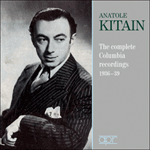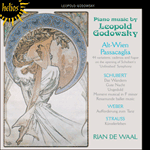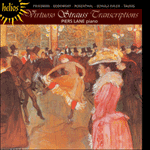
Welcome to Hyperion Records, a British classical label devoted to presenting high-quality recordings of music of all styles and from all periods from the twelfth century to the twenty-first.
Hyperion offers both CDs, and downloads in a number of formats. The site is also available in several languages.
Please use the dropdown buttons to set your preferred options, or use the checkbox to accept the defaults.

Wein, Weib und Gesang (‘Wine, Woman and Song’) is Strauss’s Op 333 and, like The Blue Danube, was originally a choral waltz commissioned by the Vienna Men’s Choral Society, though both are seldom heard in this form. The date of Godowsky’s arrangement is unknown but it follows the same pattern as Künstlerleben, that is a lengthy introduction of Godowsky’s devising followed by a procession of elaborate contrapuntal treatments of Strauss’s waltz themes in the same order as the Strauss originals.
The paraphrase on Die Fledermaus (‘The Bat’) has, necessarily, a different structure, its themes being taken from two acts of Strauss’s comic operetta premiered in Vienna in 1874 (the only one of his operas set in Vienna itself). Godowsky obligingly indicates which numbers he is using by placing the appropriate lyrics above or within the stave. Thus the opening bars have ‘Oh je, oh je, wie rührt mich dies’ (the Act I Trio), followed by ‘Brüderlein, Brüderlein und Schwesterlein’ (the ensemble from Act II) and, at varying intervals, snatches of ‘Mein Herr Marquis’ (Adele’s Laughing Song, Act II). In other words, there is no narrative logic to the themes: Godowsky uses them instead to weave his ingenious web at will: ‘Johann Strauss waltzing with Johann Bach’, according to Albert Lockwood (Notes on the Literature of the Piano, 1940).
Godowsky’s Die Fledermaus metamorphosis (not ‘pot-pourri’, as one leading record catalogue persists in titling the piece) was completed in November 1907. Godowsky was evidently pleased with himself, judging from the letter he wrote to Maurice Aronson the day he finished work on it: ‘Aside from what you know of the Valse, I have added several original features. Between the second theme of the first valse and the first theme of the second valse, I introduce a very short parody on Richard Strauss (something like Till Eulenspiegel and a bit of Salomé cacophony). It is rather amusing, not unmusical but queer, stranger than the beginning. The transition between the second theme of the second valse and the first theme of the third valse is perhaps the most delicately impassioned passage I have ever written—it has genuine vitality! I think the end is a complete success. You know how long I worry to bring a work like this to a proper climax … This part is almost unplayable, but will sound well when I can play it. A sudden modulation from E flat to E major, from ff to p, from bravura playing to poetry, and after several measures the real climax comes on gradually until it bursts into a triumph with a “Steigerung” quite Wagnerian. I think it very successful. I may be mistaken.’
Godowsky’s three Symphonische Metamorphosen Johann Strauss’scher Themen, Drei Walzer-paraphrasen für das Pianoforte zum Concert Vortrag were published by Cranz in 1912. Die Fledermaus is dedicated to Frau Johann Strauss (that is Strauss’s widow, Adele, his third wife); Künstlerleben is dedicated to Herrn und Frau Josef Simon; Wein, Weib und Gesang is dedicated to Herrn Regierungsrat Dr Heinrich Steger, a distinguished Viennese lawyer and member of the Board of Directors of the Conservatory who had first sounded out Godowsky about the directorship of the Piano School. If Godowsky’s aim was to elevate the art of the piano paraphrase to a higher musical and pianistic plane, then he certainly succeeded. ‘These [three works] are probably the last word in terpsichorean counterpoint’ (Lockwood again). This is only the fifth time that all three of Godowsky’s Symphonic Metamorphoses have appeared on the same disc—the others are by Edith Farnadi, Janice Weber (twice) and Antony Rollé.
from notes by Jeremy Nicholas © 2008
Tout comme Le beau Danube bleu, Wein, Weib und Gesang («Vin, femme et chant»), l’op. 333 de Strauss, fut d’abord une valse chorale commandée par la Société chorale masculine de Vienne—mais cette version première est, dans les deux cas, rarement jouée. Le présent arrangement, dont on ignore la date, reprend le schéma de Künstlerleben, savoir une très longue introduction imaginée par Godowsky suivie d’un cortège de thèmes de valse straussiens pris dans l’ordre original et soumis à des traitements contrapuntiques élaborés.
La paraphrase sur Die Fledermaus («La Chauve-Souris») a forcément une structure différente, ses thèmes provenant de deux actes de l’opérette comique de Strauss créée à Vienne en 1874 (le seul opéra straussien à avoir pour cadre cette ville). Godowsky indique obligeamment quel numéro il emploie en reportant les paroles correspondantes au-dessus ou à l’intérieur de la portée. Ainsi les mesures d’ouverture arborent-elles les mots «Oh je, oh je, wie rührt mich dies» (trio de l’acte I), puis «Brüderlein, Brüderlein und Schwesterlein» (ensemble de l’acte II) et, à divers intervalles, des bribes de «Mein Herr Marquis» (air moqueur d’Adèle, acte II). Autrement dit, les thèmes ne présentent aucune logique narrative et Godowsky s’en sert plutôt pour tisser à loisir son ingénieuse toile: «Johann Strauss marchant avec Johann Bach», dira Albert Lockwood dans ses Notes on the Literature of the Piano (1940).
Godowsky acheva en novembre 1907 sa métamorphose de Die Fledermaus (qui n’est en rien un «pot-pourri», comme un grand catalogue d’enregistrements persiste à l’appeler). À en juger d’après la lettre qu’il écrivit à Maurice Aronson le jour où il finit d’y travailler, Godowsky était, à l’évidence, content de lui: «En plus de ce que tu connais de la valse, j’ai ajouté quelques traits originaux. Entre le second thème de la première valse et le premier thème de la deuxième valse, j’ai introduit une très courte parodie de Richard Strauss (quelque chose comme Till Eulenspiegel avec un peu de la cacophonie de Salomé). C’est plutôt amusant, pas dénué de musicalité mais bizarre, plus étrange que le début. La transition entre le second thème de la deuxième valse et le premier thème de la troisième valse est peut-être le passage le plus délicatement fervent que j’aie jamais écrit—il a une vraie vitalité! Je pense que la fin est une totale réussite. Tu sais depuis combien de temps je me soucie d’amener une œuvre comme celle-ci à un apogée convenable … Cette partie frôle l’injouable, mais elle sonnera bien quand j’arriverai à la jouer. Une soudaine modulation de mi bémol à mi majeur, de ff à p, du jeu de bravoure à la poésie et, après plusieurs mesures, le véritable apogée arrive peu à peu jusqu’à exploser en triomphe avec une «Steigerung» [une «intensification»—NdT] toute wagnérienne. Je la trouve très réussie. Mais je peux me tromper.»
Les trois Symphonische Metamorphosen Johann Strauss’scher Themen, Drei Walzer-paraphrasen für das Pianoforte zum Concert Vortrag furent publiées par Cranz en 1912. Die Fledermaus est dédiée à Frau Johann Strauss (la veuve de Strauss, Adèle, épousée en troisièmes noces); Künstlerleben est dédiée à Herrn und Frau Josef Simon; Wein, Weib und Gesang est dédiée à Herrn Regierungsrat Dr Heinrich Steger, émérite juriste viennois et membre du conseil d’administration du Conservatoire qui, le premier, avait sondé Godowsky pour le directorat de l’École de piano. Si le but de Godowsky était de hausser le niveau musicalo-pianistique de l’art de la paraphrase pour piano, alors il y est à coup sûr parvenu. «Elles [ces trois œuvres] sont probablement ce qui se fait de mieux en matière de contrepoint dansant» (Lockwood, de nouveau). C’est seulement la cinquième fois que les trois Métamorphoses symphoniques de Godowsky sont réunies sur le même disque—les quatre autres enregistrements étant ceux d’Edith Farnadi, de Janice Weber (à deux reprises) et d’Antony Rollé.
extrait des notes rédigées par Jeremy Nicholas © 2008
Français: Hypérion
Wein, Weib und Gesang ist das op. 333 von Strauß und war wie die Blaue Donau ursprünglich ein Chor-Walzer, ein Auftragswerk des Männergesangvereins Wien, obwohl beide Werke in dieser Form selten zu hören sind. Das Datum von Godowskys Arrangement ist unbekannt; aber es folgt dem gleichen Muster wie Künstlerleben, d.h. eine etwas längere Einleitung aus der Feder Godowskys, gefolgt von einer Abfolge von ausgefeilten, kontrapunktischen Verarbeitungen Strauß’scher Walzerthemen in derselben Reihenfolge wie beim Original.
Die Paraphrase über Die Fledermaus hat notwendigerweise eine andere Struktur, weil ihre Themen aus den zwei Akten von Strauß’ komischer Operette entnommen sind, die ihre Premiere 1874 in Wien hatte (übrigens die einzige seiner Opern, die in Wien selbst spielt). Godowsky gibt freundlicherweise an, welche Nummern er verwendet, indem er die entsprechenden Worte über oder in den Notentext schreibt. So beginnt das Stück mit „Oh je, oh je, wie rührt mich dies“ (Terzett des 1. Aktes), gefolgt von „Brüderlein, Brüderlein und Schwesterlein“ (das Ensemble aus dem 2. Akt) und, nach verschiedenen Zwischenspielen, Motive aus „Mein Herr Marquis“ (Adeles Lachlied im 2. Akt). Wie man sieht, haben die Themen keinen inhaltlich logischen Zusammenhang. Godowsky benützt sie stattdessen, um sein geistreiches Konstrukt so zu gestalten, wie er es für richtig hält. „Johann Strauß tanzt Walzer mit Johann Bach“, wie Albert Lockwood sagt (Notes on the Literature of the Piano, 1940).
Godowskys Fledermaus-Metamorphose (nicht „Potpourri“, wie ein führender Plattenkatalog das Stück hartnäckig tituliert) wurde im November 1907 vollendet. Godowsky war offensichtlich zufrieden mit sich selbst, was aus dem Brief hervorgeht, den er an Maurice Aronson am Tag der Fertigstellung des Werkes schrieb: „Neben dem Dir bekannten Walzer habe ich einige eigene Passagen hinzugefügt. Zwischen dem zweiten Thema des ersten Walzers und dem ersten Thema des zweiten Walzers bringe ich eine sehr kurze Parodie auf Richard Strauß (so etwas wie Till Eulenspiegel und ein wenig Salome-Kakophonie). Es ist recht witzig, nicht unmusikalisch, aber ganz speziell, ungewohnter als der Anfang. Der Übergang zwischen dem zweiten Thema des zweiten Walzers und dem ersten Thema des dritten Walzers ist vielleicht die raffinierteste und leidenschaftlichste Passage, die ich jemals geschrieben habe; sie hat wirkliche Vitalität! Ich glaube, das Stück wird ein voller Erfolg. Du weißt, wie lange ich mich plage, bis ich ein Werk wie dieses in einen perfekten Zustand bringe … Dieser Teil ist fast unspielbar, aber er wird gut klingen, wenn ich ihn beherrsche. Eine plötzliche Modulation von Es-Dur nach E-Dur, von ff nach p, von „Bravura“ zur Poesie, und nach einigen Takten strebt das Stück allmählich einem endgültigen Höhepunkt entgegen, wo es mit einer geradezu Wagner-gleichen Steigerung triumphal explodiert. Ich glaube, das kommt an. Aber vielleicht irre ich mich.“
Godowskys drei Symphonische Metamorphosen Johann Strauß’scher Themen, Drei Walzer-Paraphrasen für das Pianoforte zum Concert-Vortrag erschienen 1912 bei Cranz. Die Fledermaus ist Frau Johann Strauß gewidmet (Strauß’ Witwe Adele, seine dritte Frau); die Widmungsträger von Künstlerleben sind Herr und Frau Josef Simon; Wein, Weib und Gesang ist Herrn Regierungsrat Dr. Heinrich Steger zugeeignet, einem angesehenen Wiener Rechtsanwalt und Mitglied des Direktorengremiums des Konservatoriums, der als erster bei Godowsky wegen des Direktorenpostens der Klavierabteilung vorgefühlt hatte. Wenn es Godowskys Ziel war, die Kunst der Klavierparaphrase auf eine höhere musikalische und pianistische Ebene zu heben, dann war er ohne Zweifel erfolgreich. „Diese [drei Werke] sind sicher das letzte Wort des tänzerischen Kontrapunkts“ (Lockwood). Hier ist es erst das dritte Mal, dass alle drei Symphonischen Metamorphosen von Godowsky auf einer CD erscheinen; die anderen Aufnahmen sind von Edith Farnadi, Janice Weber (zweimal) und Antony Rollé.
aus dem Begleittext von Jeremy Nicholas © 2008
Deutsch: Ludwig Madlener
 Anatole Kitain - The complete Columbia recordings, 1936-39 Anatole Kitain - The complete Columbia recordings, 1936-39Anatole Kitain (1903–1980) was an exact contemporary and fellow pupil of Vladimir Horowitz in Kiev, where he studied, as did the slightly older Simon Barere, with Felix Blumenfeld. All three developed fabulous techniques and were romantic pianists ...» More |
 Godowsky: Piano Music Godowsky: Piano Music‘A musical as well as a technical revelation … De Waal's virtuosity is awe-inspiring, and he's complemented throughout by a beautifully natural a ... ‘This disc is amazing … wild stuff, to which Rian de Waal does ample justice’ (BBC Music Magazine)» More |
 Strauss Waltz Transcriptions Strauss Waltz Transcriptions‘Once again Piers Lane demonstrates his supreme virtuosity and brilliant technique (at times it is quite unbelievable that only ten fingers are at wor ... ‘Enormous good fun … and not at all for the serious, self-important person who thinks that music has to be listened to with knotted brow … s ...» More |

